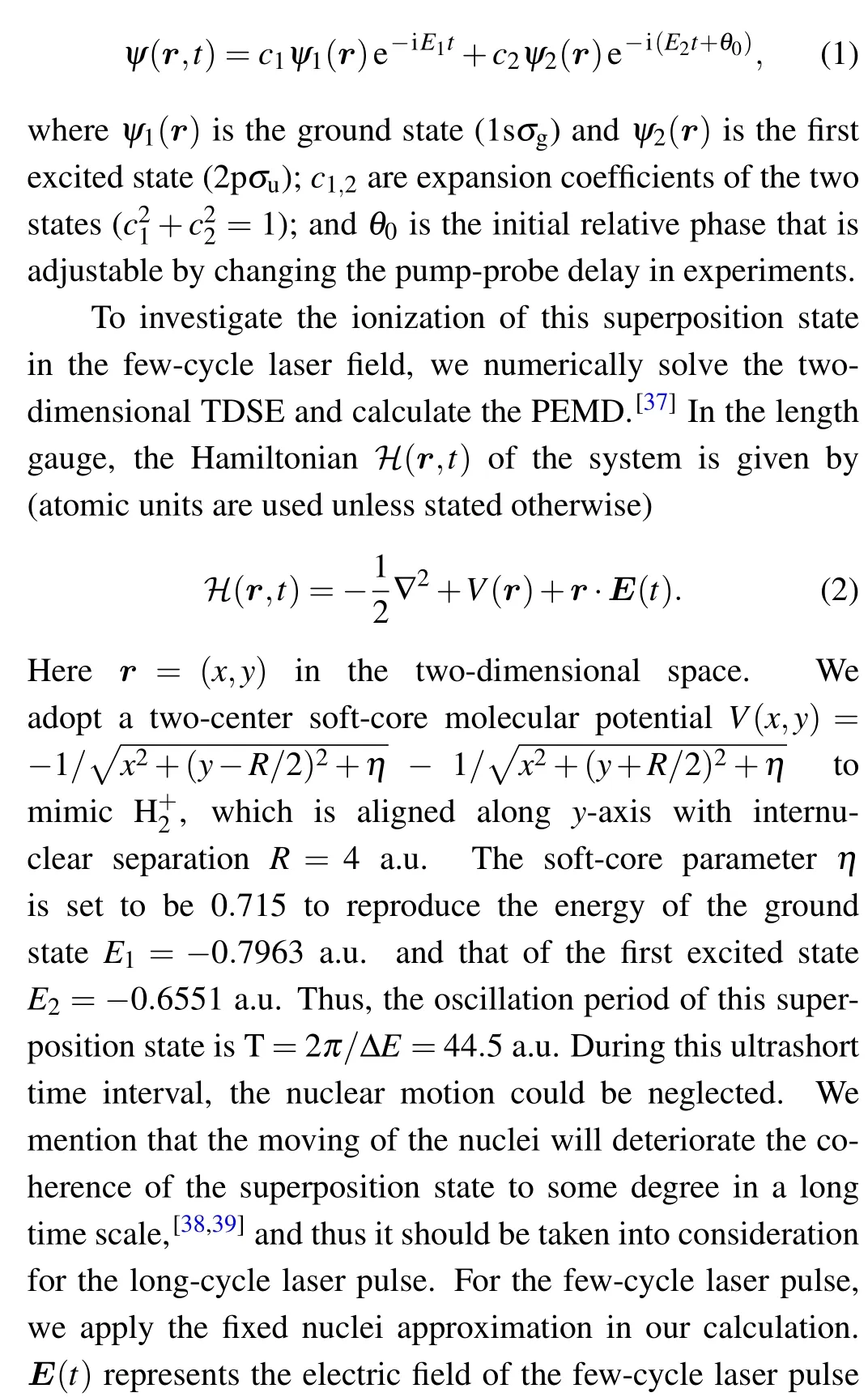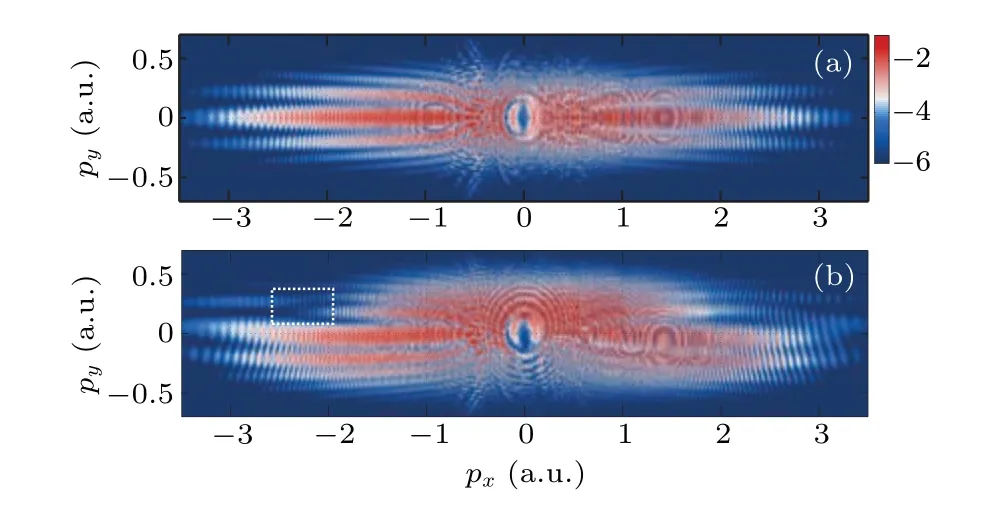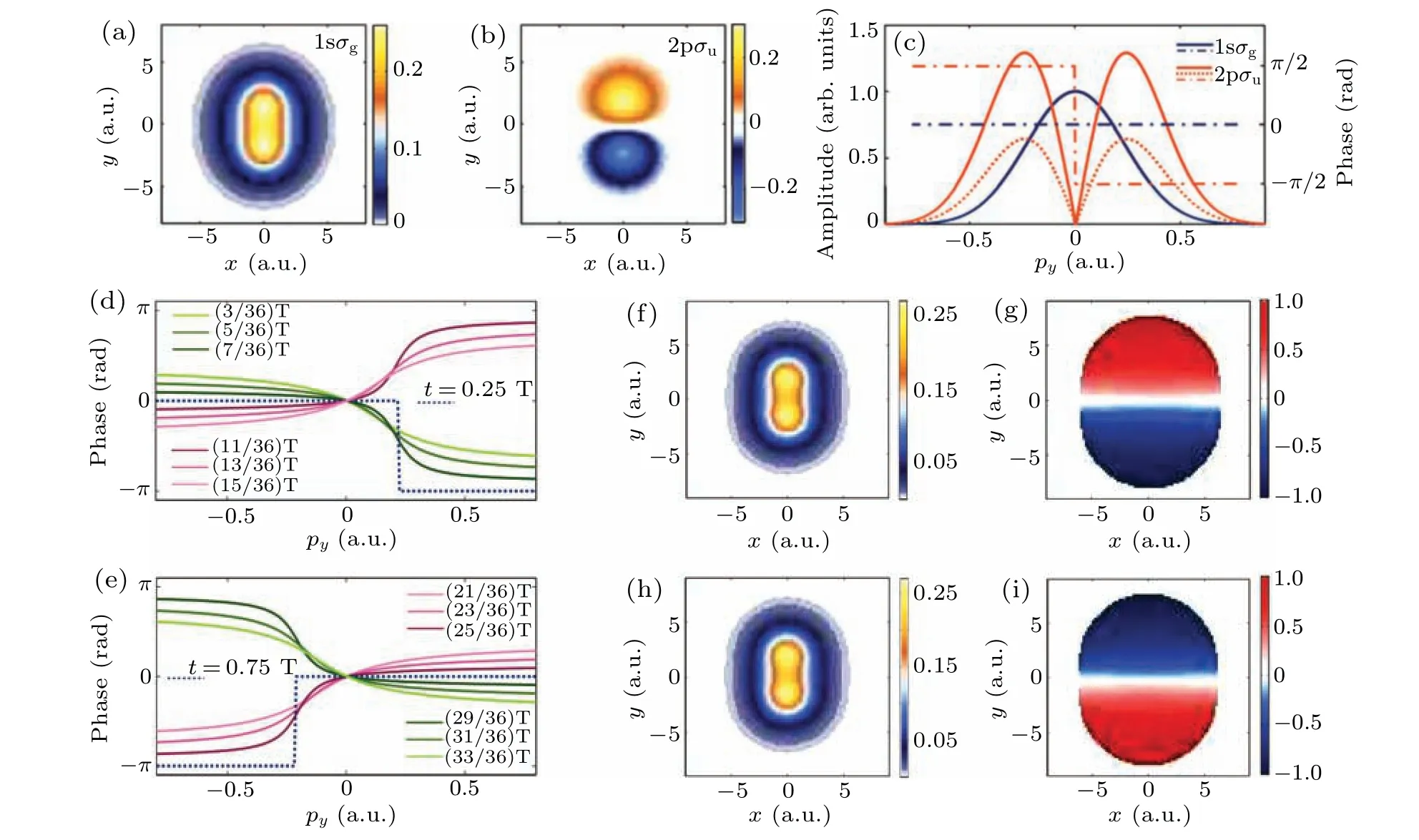Taking snapshots of a moving electron wave packet in molecules using photoelectron holography in strong-field tunneling ionization∗
2021-12-22MingruiHe何明睿YangFan樊洋YuemingZhou周月明andPeixiangLu陆培祥
Mingrui He(何明睿) Yang Fan(樊洋) Yueming Zhou(周月明) and Peixiang Lu(陆培祥)
1Department of Basic Courses,Naval University of Engineering,Wuhan 430033,China
2School of Physics and Wuhan National Laboratory for Optoelectronics,Huazhong University of Science and Technology,Wuhan 430074,China
Keywords: strong-field ionization,photoelectron holography,charge migration
1. Introduction
Exploring attosecond electronic dynamics in atoms and molecules is one of the most challenging areas in the modern attosecond science.[1]Previous studies have demonstrated that ultrafast electronic dynamics can be induced by strongfield excitation and ionization in virtually all polyatomic molecules.[2–4]The natural time scale of the valence electron dynamics ranges from a few femtoseconds to hundreds of attosenconds.[2,5]Therefore, attosecond temporal resolution is required to achieve the real-time observation. In the past decades, the rapidly developing attosecond techniques open up the way to access the electron motion on their intrinsic time scales,[6–8]inspiring widespread interests on monitoring the ultrafast electronic dynamics.[9]Previously proposed techniques for observing coherent electronic dynamics include high-order harmonic spectroscopy,[10–14]attosecond transient absorption,[15,16]ultrafast streaking[17]and electron wave packet(EWP)interferometric technique,[18–20]etc.Moreover, both x-ray scattering[21]and attosecond electron scattering[22]are also proposed as promising methods to monitor instantaneous electronic density distribution. In the area of strong-field ionization,significant progress on investigating the electronic dynamical information encoded in the photoelectron momentum spectra has been made.[23–27]With these methods, one can access coherent imaging of the attosecond electron motion and realize the control of the chemical and biological reaction process in a further step.
Complementary to those measurements, the rescattering based strong-field photoelectron holography (SFPH) is expected to be an efficient method to image the attosecond valence electron motion.[28–30]Photoelectron holographic structure in the photoelectron momentum distribution (PEMD)results from the interference between the electrons that recollide with the parent ion and electrons that reach the detector directly after tunneling ionization.[31]The rescattering process naturally provides access to both the structural information and the electronic dynamics of the atoms and molecules, and thus makes SFPH a practical photoelectron spectroscopy.[32–34]In our previous works, we extracted the inherent structural information,the phase of the scattering amplitude,from the holographic interference.[35,36]Very recently,we have demonstrated the real-time andin-situobservation of the ultrafast charge migration in molecules with attosecond temporal resolution using SFPH.[29]In that scheme, the dynamical information of the electron is retrieved from the phase of the holographic fringes, where especially high momentum resolution is necessary, and this phase extraction process requires a sophisticated procedure.
In this study, we propose a more direct method to take snapshots of the transient valence EWP with the concept of SFPH that avoids any extraction procedure. We investigate the strong-field tunneling ionization of the superposition state of H+2by numerically solving the time-dependent Schr¨odinger equation (TDSE). For the non-stationary superposition state,an unexpected bifurcation structure appears in the holographic pattern in the obtained PEMD.We demonstrate that this bifurcation structure encodes complete information of the transient electron wave function. The location of this bifurcation in the PEMD reveals the transient relative phase and the relative coefficient of the EWP.With this information,the transient EWP of the superposition state is directly visualized. Further,by investigating the superposition states with different relative coefficients ionized by the laser fields with different parameters,the accuracy and robustness of our method are verified. Our work provides a direct approach to visualize the valence electron motion with the concept of SFPH.Note that this bifurcation structure should be more easily observed in experiments.It will encourage further experimental attempt on exploring ultrafast electronic dynamics in molecules.
2. Numerical methods

In our investigation, we employ the prototypical H+2molecular ion with fixed bond length as a sample molecule,which is widely applied in the theoretical investigation of the electron motion of the surperposition state.[26,27]The H+2molecular ion is prepared in the coherent superposition of two electronic states


HereE0is the peak intensity,τis the pulse duration,ωis the angular frequency of the laser pulse;xis the unit vector alongxdirection. This electric field ensures that the vector potential is zero at the beginning and the end of the laser pulse.
The split-operator spectral method on a Cartesian grid is used to solve the TDSE.[37]In our simulation,the time step of propagation is ∆t=0.1 a.u. At the end of the laser pulse,the wave function is further propagated for additional 1000 a.u.to ensure that all the ionized components are collected. The Cartesian grid ranges from−400 a.u. to 400 a.u. for both directions with ∆x=∆y=0.2 a.u. Convergence is checked with respect to the spatial and temporal grid densities and sizes.
3. Formation of the bifurcation in the photoelectron momentum distribution
We use a 2000 nm pulse with the intensity of 3.0×1014W/cm2and full width at half maximum (FWHM) of 11.5 fs to ionize H+2. The PEMDs for the tunneling ionization of the ground state and the superposition state (withc1:c2=2 andθ0=0) are presented in Figs. 1(a) and 1(b),respectively. Several kinds of interference patterns are entangled with each other in the PEMD. The ring-like pattern visible in the low energy part is the familiar above-threshold ionization (ATI) structure,[40]which results from the interference of the EWPs tunneling ionized at different laser cycles. The nearly vertical fine fringes are the intracycle interference fringes of electrons liberated at adjacent half cycles,which are usually interpreted as the time-domain double-slit interference fringes.[40–42]These stripes are hardly observed in experiments because their positions are very sensitive to the laser field intensities, and thus are averaged out in the integrated signal from the laser focal volume. The most pronounced nearly horizontal fringes are the near-forward SFPH we will focus on.[31]For the PEMD of the ground state, this type of interference is exactly symmetric aboutpy=0,while for the superposition state, it is obviously asymmetric aboutpy=0. In our previous study, we proposed a sophisticated procedure to extract the electronic dynamics of the superposition state from these asymmetric SFPH patterns.[29]Intriguingly,in Fig.1(b),a clear bifurcation structure appears in the PEMD(atpx=−2.27 a.u.,py=0.20 a.u.),where the first-and second-order interference maxima merge into a single fringe,as indicated by the white square.This structure is absent in the PEMD of the ground state.In the following,we will show that this structure is a consequence of the electron motion of the non-stationary state and it provides snapshots of the transient EWP of this state.

Fig.1. (a)Photoelectron momentum distribution(PEMD)for the tunneling ionization of the ground state of H+2 by the few-cycle laser pulse.The wavelength of this laser pulse is 2000 nm and the intensity is 3.0×1014 W/cm2. The pulse duration (FWHM) is 11.5 fs. (b) The same as (a), but for the superposition state of H+2, which is composed of the ground state 1sσg and the first excited state 2pσu with expansion coeffciients The white square indicates the bifurcation structure.
As demonstrated in our previous works,[29,35]the holographic structure originates from the interference between the EWPs that reach the detector with and without the nearforward rescattering by the parent ion,

whereIdandIrare the direct and rescattering parts of the ionization amplitude, respectively.[43]∆ϕis the interference phase in the form[29,35]

Herepyis the transverse momentum,ti,rare the instants of the ionization and recollision, respectively. The first term on the right-hand side of Eq. (5) has a classical origin and has been discussed in Refs.[31,44]. The second termαis the phase of the scattering amplitude, which is first revealed in Ref. [35].The third term is related to the electronic dynamics of the nonstationary state.[29]Here,φ(py;ti) andφ(0;ti) are the phases of transverse momentum distribution amplitudes(TMDAs)for the direct and rescattering electrons at the instant of tunneling,respectively. Note that for the rescattering electron, the initial transverse momentum at tunneling should be zero,and for the direct electron, the final transverse momentum equals the initial value.[29]The TMDA of the ground state possesses a global phase, and thus the third termφ(0;ti)−φ(py;ti)=0 disappears in Eq.(5). For the superposition state,as the electron wave function evolves, the TMDA has nontrivial phase structure,so that the third term in Eq.(5)contains valuable information about the electron motion. In this case,the TMDA has the form

whereθ(t)=∆Et+θ0andA1,2represent TMDAs of 1sσgand 2pσustates, respectively. To explain the formation of the bifurcation in Fig.1(b),we calculate the TMDAs with the same laser parameters as those used in Fig. 1. The moduli ofA1,2are presented by the solid colored curves in Fig.2(c).For 1sσgstate,the modulus of the TMDA has a Gaussian-like form.For the 2pσustate,the modulus of the TMDA has a node atpy=0.The phases ofA1,2are also shown in Fig.2(c)by the dasheddotted curves. ForA1(py), it is always zero, and forA2(py),there is a jump fromπ/2 to−π/2 atpy=0. The phase of the TMDA of the superposition state can be expressed as

where sgn is the sign function. In Figs. 2(d) and 2(e), we displayφ(py;t) at different instants. It is clearly shown that these phases are smooth functions ofpyexcept the instants oft=0.25 T and 0.75 T,where there are abrupt jumps. Because of the phase jump in the TMDA,the holographic interference phase[as expressed by Eq.(5)]jumps accordingly. Thus,the bifurcation structure appears in the holographic pattern.


Fig.2. (a)and(b)The electron wave functions of the ground state 1sσg and the first excited state 2pσu of H+2 in coordinate space,respectively.(c)The transverse momentum distribution amplitudes(TMDAs)A1,2 of 1sσg state(blue curves)and 2pσu state(orange curves). The moduli of the amplitudes are shown as the solid curves,and the phases are shown as dash-dotted lines. The dotted orange curve represents the quantity|A2(py)|/2.The laser parameters are the same as Fig.1. (d)and(e)The phases of TMDAs of the superposition state with c1:c2=2 at different instants around t=0.25 T and t=0.75 T.(f)and(g)The modulus and phase of the EWP of the superposition state at the instant of t=0.25 T.(h)and(i)The same as(f)and(g)but at the instant of t=0.75 T.

Fig.3.(a)The electric field(red curve)and the vector potential(blue curve)of the few-cycle laser pulse used in Fig. 1. The orange asterisk indicates the tunneling ionization time corresponding to the longitudinal momentum of the bifurcation structure in Fig.1(a). (b)and(c)The reconstructed modulus and phase of the electron wave function of the superposition state at the instant indicated by the asterisk in(a),respectively.
We investigate the ionization of the superposition state of H+2with the initial phaseθ0=0.5πand relative coefficientc1:c2ranges from 2 to 6 in the 2000 nm laser field. Here the intensity of the laser field is 3.0×1014W/cm2and the duration(FWHM) is 6.9 fs. As explained above, the transverse locationpyof the bifurcation structure should satisfy the equation|c1A1(py)|=|c2A2(py)|, and thus it changes withc1:c2. As presented in Fig.4(c),pyof the bifurcation structure for differentc1:c2is indicated by the crossing of the solid blue curve and the corresponding dotted curve. Here two sets of cross points appear. The positive (negative) set ofpycorresponds to the relative phaseθ(t)=2nπ+π/2 (2nπ+3π/2). In the obtained PEMDs,clear bifurcation structures appear with positivepy. Two examples of the bifurcation structures are shown in Figs. 4(a) and 4(b), indicated by the white squares in the PEMDs forc1:c2=2 and 3, respectively. The longitudinal locationspxof them are close to each other (2.08 a.u. and 2.03 a.u. in Figs. 4(a) and 4(b), respectively). The corresponding ionization time forpx=2.03 a.u. ist=23.5 a.u.At this instant, the relative phase of the superposition state should be 2nπ+π/2. The transverse locationspyof the bifurcation structures change with the relative coefficients, as presented by the red circles in Fig. 4(d). For comparison,we present the precise solution (positive set) of the equality|c1A1(py)|=|c2A2(py)| as a function ofc1:c2by the solid blue curve. One can find that the agreement between the red circles and the blue curve is prominent for largepy,while the red circle deviates from the blue curve slightly at smallpy.This is because the influence of the coulomb potential is more remarkable for the electron with small transverse momentum.These results demonstrate that the transverse location of the bifurcation structure is sensitive to the relative coefficient,and thus it provides accurate information about the EWP of the non-stationary state.

Fig.4. (a)The PEMD of the superposition state with the relative coefficient c1:c2=2 and the initial relative phase θ0=0.5π. (b)The same as(a)but for c1:c2=3. (c)The solid curve represents the modulus of the TMDA of 1sσg state(|A1|). The colored dotted curves indicate the quantity c2|A2(py)|/c1 with five different relative coefficients c1 :c2. (d)The red circles indicate the transverse momenta of the bifurcations extracted from the PEMDs for the superposition state with five different relative coefficients as same as(c). The blue curve present the precise solution(positive set)of the equality c1|A1(py)|=c2|A2(py)|as a function of the ratio c1:c2 for comparison. The FWHM of the laser pulse is about 6.9 fs and the intensity of the laser pulse is 3.0×1014 W/cm2.
4. Conclusion
In summary,we have proposed a method based on SFPH to take snapshots of the EWP of the superposition state. For the strong-field tunneling ionization of the coherent superposition state of H+2,an interesting bifurcation structure appears in the PEMD,which encodes complete information about the transient electron wave function. The longitudinal location of this structure indicates the transient relative phase between the components of the superposition state, and the transverse location reveals the relative coefficient. With this information,we are able to obtain the instantaneous electron wave function of the superposition state. Then we apply our method to investigate the coherent superposition states with different relative coefficients. The transient EWPs of these states are obtained by investigating the bifurcation structure. This result demonstrates that our method is efficient to visualize the ultrafast electron motion.Our work provides a feasible approach to monitor the electron motion in more complicated molecules.
杂志排行
Chinese Physics B的其它文章
- Transient transition behaviors of fractional-order simplest chaotic circuit with bi-stable locally-active memristor and its ARM-based implementation
- Modeling and dynamics of double Hindmarsh–Rose neuron with memristor-based magnetic coupling and time delay∗
- Cascade discrete memristive maps for enhancing chaos∗
- A review on the design of ternary logic circuits∗
- Extended phase diagram of La1−xCaxMnO3 by interfacial engineering∗
- A double quantum dot defined by top gates in a single crystalline InSb nanosheet∗
